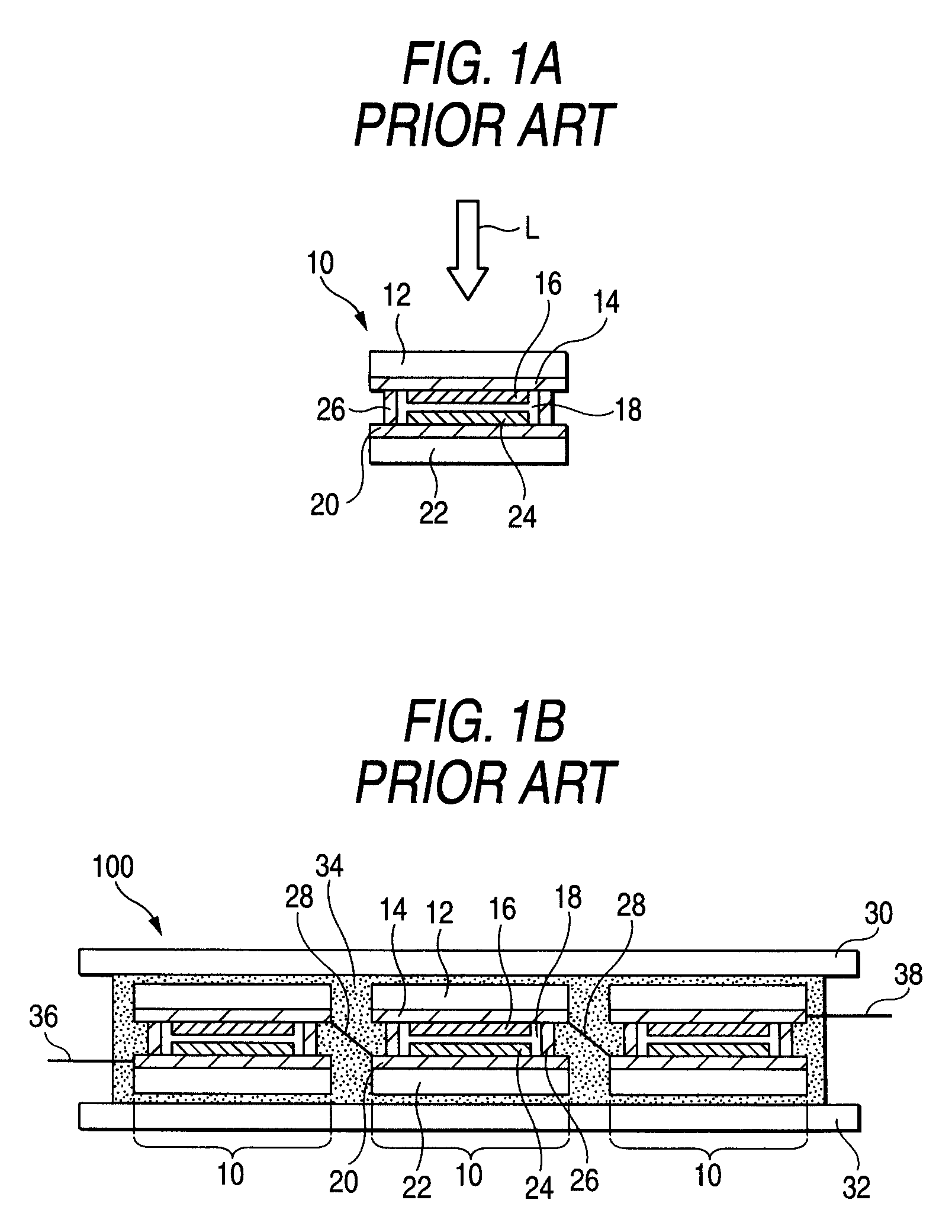Dye sensitized solar cell module and manufacturing method thereof
a solar cell module and sensitized technology, applied in the direction of cell components, final product manufacturing, sustainable manufacturing/processing, etc., can solve the problems of increasing the number of module fabricating steps, increasing the manufacturing cost of both the module structures shown in fig. 1a, b>1/b>b and b>2/b>, and the output voltage is relatively low. , to achieve the effect of high photoelectric conversion efficiency, high cell numerical aperture, and improved structur
- Summary
- Abstract
- Description
- Claims
- Application Information
AI Technical Summary
Benefits of technology
Problems solved by technology
Method used
Image
Examples
first embodiment
[0063]FIGS. 4A to 4C show the example of sectional structures of a dye sensitized solar cell module according to a preferred embodiment of the invention.
[0064]A dye sensitized solar cell module 401 according to the invention shown in FIG. 4A is constituted by arranging a plurality of dye sensitized solar cells 410 on a plane basis and connecting them in series with an intercell region 415 interposed therebetween.
[0065]A first transparent substrate 412, a first transparent conductive film 414, a dye carrying oxide semiconductor layer 416, an electrolyte layer 418, a catalyst layer 424, a second transparent conductive film 420 and a second transparent substrate 422 are laminated.
[0066]The first transparent substrate 412 and the second transparent substrate 422 are continuous single substrates which are common to all of the dye sensitized solar cells 410, respectively.
[0067]The first transparent conductive film 414 is constituted by an electrode portion 414E provided in the cell 410 an...
second embodiment
[0071]FIGS. 5A to 5C show the examples of sectional structures of a dye sensitized solar cell module according to a further preferred embodiment of the invention.
[0072]Dye sensitized solar cell modules 401A, 402A and 403A shown in FIGS. 5A, 5B and 5C have features that a first auxiliary conductive layer 430 and a second auxiliary conductive layer 432 are added to the extended portion 414T of the first transparent conductive film 414 and the extended portion 420T of the second transparent conductive film 420 which are connected to the electrode connecting portion 428 respectively in the structures of the dye sensitized solar cell modules 401, 402 and 403 shown in FIGS. 4A, 4B and 4C.
[0073]In the embodiment shown in FIG. 5A (a configuration in which an electrode connecting portion 428 penetrates through a second transparent substrate 422 on a catalyst layer 424 side and is exposed), the first auxiliary conductive layer 430 is added to compensate for a thickness of the first transparen...
example 1
Example of Manufacture of Structure According to the First Embodiment
[0077]The dye sensitized solar cell module according to each of the embodiments shown in FIGS. 4A, 4B and 4C can be manufactured by the same method. A manufacturing method will be described below by setting the case of the embodiment shown in FIG. 4A to be a typical example. FIG. 6A to FIG. 12D sequentially show the manufacturing steps thereof.
[0078]First of all, as shown in a section of FIG. 6A, a first transparent conductive film 414 is formed over a whole surface of a first transparent substrate 412. It is possible to use a product put on the market (A110U80 manufactured by Asahi Glass Company) in a state in which the FTO (fluorine-doped tin oxide) film 414 is formed on the glass substrate 412. A thickness of the first transparent conductive film 414 is equal to or greater than 0.1 μm and is usually approximately 0.3 to 2 μm.
[0079]For the first transparent conductive film 414, SnO2 (tin oxide), ATO (antimony-dop...
PUM
| Property | Measurement | Unit |
|---|---|---|
| thickness | aaaaa | aaaaa |
| thickness | aaaaa | aaaaa |
| width | aaaaa | aaaaa |
Abstract
Description
Claims
Application Information
 Login to View More
Login to View More - R&D
- Intellectual Property
- Life Sciences
- Materials
- Tech Scout
- Unparalleled Data Quality
- Higher Quality Content
- 60% Fewer Hallucinations
Browse by: Latest US Patents, China's latest patents, Technical Efficacy Thesaurus, Application Domain, Technology Topic, Popular Technical Reports.
© 2025 PatSnap. All rights reserved.Legal|Privacy policy|Modern Slavery Act Transparency Statement|Sitemap|About US| Contact US: help@patsnap.com



